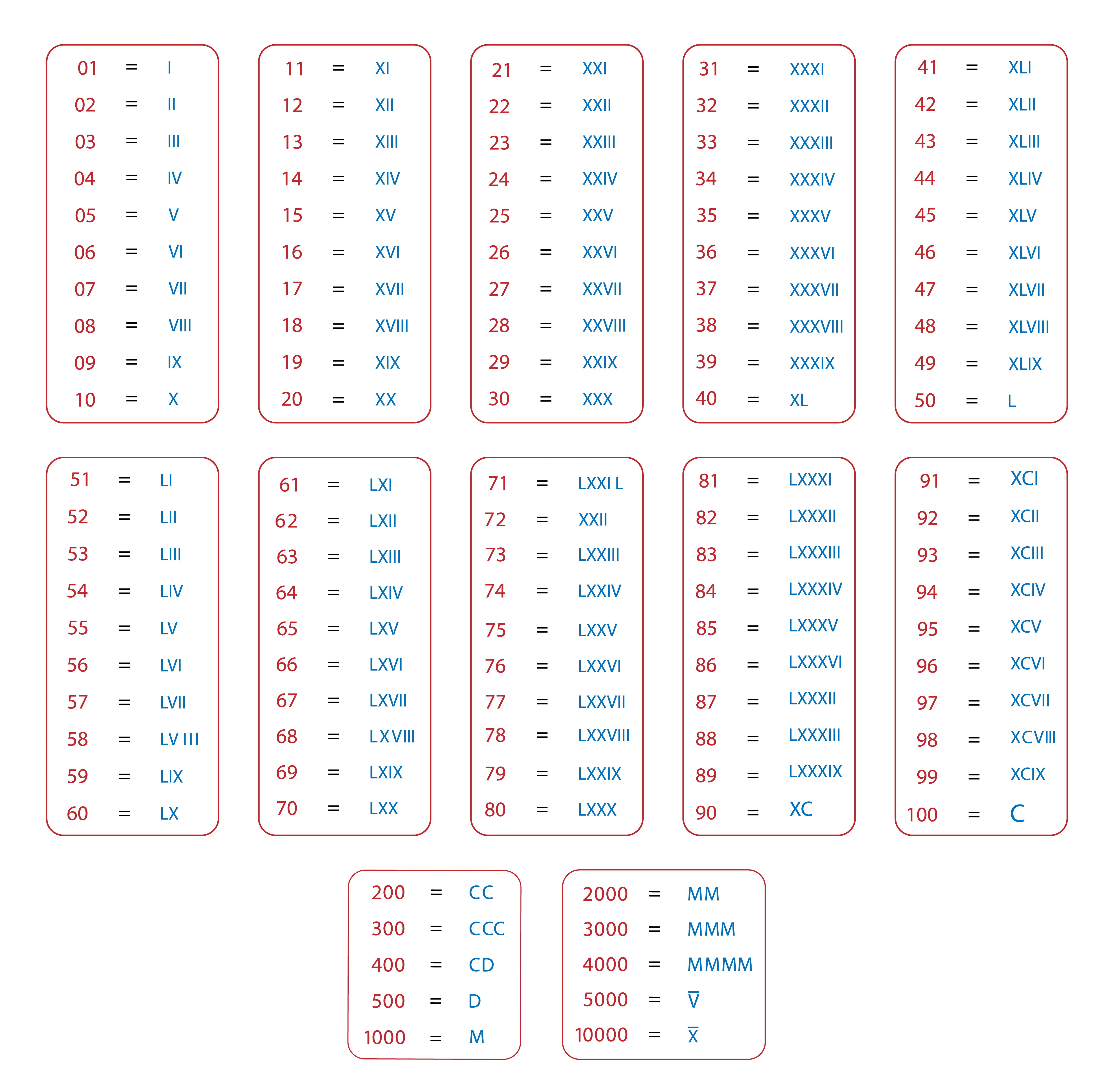
Roman numbers 1 to 10000 are written using an ancient number system developed by the Romans, where letters are used instead of digits. Each symbol has a fixed value. For example, I for 1, V for 5, X for 10, L for 50, C for 100, D for 500, and M for 1000.
These letters are combined using a set of rules based on addition and subtraction. For example, VI represents 6, while IV represents 4. In this blog, you will learn how to write Roman numbers from 1 to 10000 using the correct combinations of symbols. The question of how to write 10000 in Roman numerals commonly arises among students.
You will also understand the rules behind the system and become familiar with the common errors students generally make when reading or writing Roman numerals.
Read More - Numbers: Definition, Types, and Properties
What Are Roman Numbers?
Roman numerals are a system of numerical notation based on combinations of letters from the Latin alphabet. The core symbols and their values are:
-
I = 1
-
V = 5
-
X = 10
-
L = 50
-
C = 100
-
D = 500
-
M = 1000
By combining these letters according to specific rules, different roman numbers can be formed. For instance:
-
II = 2
-
IV = 4
-
XII = 12
-
XXIX = 29
-
XL = 40
-
XC = 90
-
CD = 400
-
CM = 900
Roman numbers are formed using a combination of adding and subtracting values. When a letter with a higher value comes first, followed by smaller ones, you add them together. The Roman numerals 10000 can be written as (X̄), with the multiplication of 1,000 indicated by the bar above the number. The roman number 10,000 is so shown in this expanded form.
For example, 12 is written as XII. X is 10, and each I is 1. Since the smaller values follow the larger one, you add them: 10 + 1 + 1 = 12.
In some cases, a smaller value comes before a larger one. This means you subtract. For example, 4 is written as IV. I is 1 and V is 5. Since 1 comes before 5, you subtract: 5 − 1 = 4.
This rule also applies to numbers like 9, written as IX, where 1 comes before 10, so it becomes 10 minus 1, which equals 9.
Read More - Co Prime Numbers - Definition, Properties and Examples
Roman Numerals 1 to 10000 Chart
Generally, the basic system covers 1 to 10000 Roman number representations. Below is the Roman numerals 1 to 10000 chart that highlights key numbers like 1, 5, 10, 50, 1000, 5000, 10000, and beyond. This chart is a quick reference to understand how major values are written using Roman number 10000 symbols.

|
Roman Numerals 1 to 10000 Chart |
|||||||
|
Numbers |
Roman Numerals |
Numbers |
Roman Numerals |
Numbers |
Roman Numerals |
Numbers |
Roman Numerals |
|
1 |
I |
56 |
LVI |
223 |
CCXXIII |
1000 |
M |
|
10 |
X |
60 |
LX |
334 |
CCCXXXIV |
2000 |
MM |
|
12 |
XII |
67 |
LXVII |
445 |
CDXLV |
3000 |
MMM |
|
20 |
XX |
70 |
LXX |
556 |
DDLVI |
4000 |
I̅V̅ |
|
23 |
XXIII |
78 |
63 |
667 |
DCLXVII |
5000 |
V̅ |
|
30 |
XXX |
80 |
LXXX |
778 |
DCCLXXVIII |
6000 |
V̅I |
|
34 |
XXXIV |
89 |
LXXXIX |
889 |
DCCCLXXXIX |
7000 |
V̅II |
|
40 |
XXXX |
90 |
XC |
900 |
CM |
8000 |
V̅III |
|
45 |
XLV |
100 |
C |
950 |
CML |
9000 |
Ⅿ̅ |
|
50 |
L |
112 |
CXII |
975 |
CMLXXV |
10000 |
X̅ |
Roman Numbers 1 to 50
When learning Roman numerals, starting small is helpful. The set of Roman numbers 1 to 50 covers a wide range of combinations and helps build a strong foundation. The proper Roman numeral for 10000 is X̄, distinguishing it from lesser quantities such as I, V, X, L, C, D, and M.
Here’s a reference for some key values:
-
1 = I
-
5 = V
-
10 = X
-
20 = XX
-
30 = XXX
-
40 = XL
-
50 = L
Learning Roman numbers 1 to 50 is a great way to understand the additive and subtractive rules that define the entire system. For example:
-
7 is written as VII (5 + 1 + 1)
-
9 is IX (10 - 1)
-
24 is XXIV (10 + 10 + 4)
Once you are comfortable with the patterns in Roman numbers 1 to 50, it becomes much easier to extend your knowledge to higher numbers.
Roman Numbers 1 to 100
As we move beyond 50, the next major milestone is learning Roman numbers 1 to 100. This range introduces more frequent use of L (50) and C (100/ Here are some common Roman numbers in this range:
-
60 = LX (50 + 10)
-
70 = LXX (50 + 10 + 10)
-
80 = LXXX (50 + 10 + 10 + 10)
-
90 = XC
-
100 = C
In Roman numbers 1 to 100, the subtractive method is used more often. For example, XL means 40 because X is 10 and L is 50. When a smaller number comes before a bigger one, you subtract. So 50 minus 10 equals 40.
The same rule applies to XC, which means 90. X is 10 and C is 100. Since 10 comes before 100, you subtract 10 from 100, which gives you 90.
These patterns make Roman numerals easier to read and write without repeating the same letter too many times. Once you learn the rules from Roman numbers 1 to 50, applying them up to 100 becomes simple.
Read More - Indian Numeral System: Place Value Chart, Rules, and Examples
Roman Numbers 1 to 1000
After learning Roman numbers up to 100, the next step is understanding Roman numbers 1 to 1000. This range introduces larger values and new letter combinations, especially using C (100), D (500), and M (1000).
In Roman numbers 1 to 1000, larger values are written using combinations of C, D, and M. For example:
-
400 is written as CD. Here, C is 100 and D is 500. Since 100 comes before 500, you subtract: 500 minus 100 equals 400.
-
500 is written as D. No subtraction is needed here, as it is a single symbol.
-
900 is written as CM. C is 100 and M is 1000. Since 100 comes before 1000, you subtract: 1000 minus 100 equals 900.
-
1000 is written as M, the symbol that stands for 1000 on its own.
Now let’s see how these combine in full numbers:
-
444 is written as CDXLIV — 400 (CD), 40 (XL), and 4 (IV)
-
789 becomes DCCLXXXIX — 500 (D), 100 + 100 (CC), 50 + 10 + 10 + 10 (LXXX), and 9 (IX)
-
999 is CMXCIX — 900 (CM), 90 (XC), and 9 (IX)
While the numbers may look longer, they still follow the same patterns you have already learned. Add when a smaller value follows a larger one, and subtract when a smaller value comes first.
Once you are familiar with these rules, working with Roman numbers 1 to 1000 becomes much easier and more intuitive, especially when reading historical texts, monuments, or formal inscriptions.
Read More - Value of Cubes From 1 to 20: Table, List, Examples
Roman Numbers 1 to 10000
When asked what is the Roman number of 10000, the correct answer remains X̄, which is different from smaller values like I, V, X, L, C, D, and M. The traditional Roman numeral system was made for numbers up to 3999. But to write larger numbers, like those in Roman numerals 1-10000, people started using special methods.
One common method is to place a bar over a numeral. This means you multiply the value by 1000. For example, V̅ means 5000 and X̅ means 10000. Since X represents 10, placing a bar above it turns it into 10 × 1000.
This extended format helps represent numbers that are not possible with standard Roman numerals. So, 10000 is written as X̅.
This system is especially useful when reading historical documents, ancient manuscripts, or formal inscriptions that use large Roman numerals. It helps expand the traditional number range clearly and consistently.
Here are a few examples from Roman numbers 1 to 10000:
3000 = MMM
4000 = ĪV̅ or (IV)
6000 = V̅I
7000 = V̅II
9000 = ĪX̅ or (IX)
10000 = X̅
These forms allow Roman numerals to go beyond their original limits while keeping their structure and style.
Read More - Descending Order: Definition, Symbol, Example and Decimal
Roman Numbers Examples in Everyday Life
Even today, 10000 in Roman number show up in everyday places:
-
Clock faces often use Roman numerals (I to XII).
-
Movie titles, like Rocky III or Star Wars Episode IV.
-
Book chapters and outlines.
-
Monarch names, such as Queen Elizabeth II or Louis XIV.
-
Events and sports, like the Olympic Games and the Super Bowl numbers.
This continued usage is part of why understanding Roman numbers remains valuable.
Common Mistakes to Avoid when Using Roman Numbers
Learning Roman numerals can be confusing at first, especially if you're not familiar with the rules. Here are some common mistakes to avoid:
1. Repeating a numeral too many times: You should never use the same symbol more than three times in a row. For example, 4 is written as IV, not IIII.
2. Using the wrong letters for subtraction: Only I, X, and C can be used in the subtractive way. For example, 95 should be written as XCV (100 − 10 + 5), not VC, which is not correct.
3. Putting the symbols in the wrong order: Roman numerals must be written from largest to smallest values, unless you are using the subtractive rule. For example, XVI is 10 + 5 + 1 = 16. Writing it as VXI would be incorrect.
To avoid these mistakes, it helps to study the correct patterns in Roman numbers 1 to 100, 1 to 1000, and 1 to 10000. The more you practice, the easier it becomes to use Roman numerals correctly and confidently.
Read More - Standard Deviation: Definition, Formula, Learn How to Calculate
Roman Numerals 1 to 10000 Solved Examples
When looking up 10,000 in Roman numerals, students should keep in mind that this form is part of the highlighted Roman numeral system, which is commonly utilized for extremely big numbers beyond 3999. Here are some examples of Roman numerals 1-10000 given below:
-
Write 244 in Roman numerals.
Solution: 244 = 200 + 40 + 4
= (100 + 100) + (50 − 10) + (5 − 1)
= CC + XL + IV
= CCXLIV
Thus, 244 = CCXLIV.
-
Write 789 in Roman numerals.
Solution: 789 = 500 + 100 + 100 + 50 + 10 + 10 + 10 + 5 + 1 + 1 + 1
= D + C + C + L + X + X + X + V + I + I + I
= DCCLXXXIX
Thus, 789 = DCCLXXXIX.
-
Write 999 in Roman numerals.
Solution: 999 = 900 + 90 + 9
= (1000 − 100) + (100 − 10) + (10 − 1)
= CM + XC + IX
= CMXCIX
Thus, 999 = CMXCIX.
-
Write 5000 in Roman numerals.
Solution: 5000 = 5 × 1000
This is written as V with a bar on top, or in simplified form as (V)
= V̅ or (V)
Thus, 5000 = V̅ or (V)
Roman numbers 1 to 10000 are written using letter-based symbols and follow simple rules of addition and subtraction. Numbers beyond 3999 use overlines to show multiplication by 1000, making it possible to write values like 5000 as V̅ and 10000 as X̅. By understanding these methods, you can write Roman numerals correctly at any level.
Join CuriousJr Online Classes for Kids Now.










